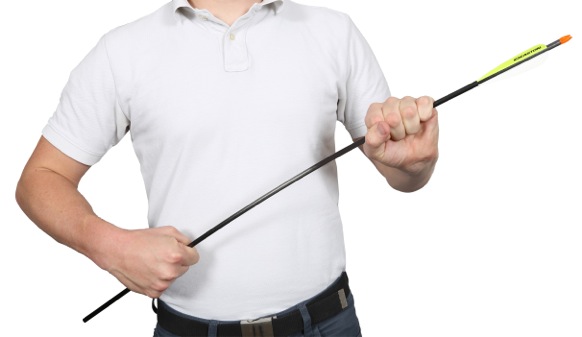Arrow Safety
Any arrow can become damaged. A damaged arrow could break upon release and injure you or a bystander. Damage to an arrow shaft, or any of its components, may occur from: improper transport, handling, or use; impacts with hard objects or other arrows; or, after being shot into a game animal. No list can cover all possible conditions and situations that may cause damage. Use good judgment and common sense, as well as follow the warnings and instructions below, to determine if your arrow has been damaged in any way. WARNING! NEVER SHOOT A DAMAGED ARROW.
ARROW USE PRECAUTIONS Before each shot (including the first shot of a new arrow) carefully inspect each arrow shaft, nock, and other components to see that they have not been damaged. Before shooting, place the arrow between your thumb and fingers, and using your other hand to slowly rotate the shaft, run your fingertips along the entire arrow length, feeling and looking closely for nicks, cracks, splits, dents or other marks that could indicate the shaft has been damaged. If your arrow is crested, inspect for damage on the crest surface. You may need to remove the cresting to make a thorough inspection. If shaft damage is present,NEVER EVER USE A DAMAGED ARROW.
Before each shot, inspect the nock for damage. If the nock is damaged, replace the nock. NEVER SHOOT AN ARROW WITH A DAMAGED NOCK. Before each shot, check that the nock is fully seated, and fits tightly in the shaft. Apply twisting pressure to see if the nock turns easily. If the nock has backed out of the arrow or the fit is loose (rotates easily), inspect further for cracks in the nock end of the arrow shaft. If applicable, you may need to remove the cresting to make a thorough inspection. If there are cracks in the shaft or the nock is loose, DISCARD THE ARROW. WARNING! NEVER SHOOT A DAMAGED ARROW. ADDITIONAL TESTS FOR CARBON ARROWS When checking carbon arrows, perform the following additional tests: Grasp the shaft just above the point and below the nock, then flex the arrow in an arc (bending it away from you and others) with a deflection of 1 to 2 inches (2.5 to 5 cm), and feel and listen for cracking. Perform this test four to six times, rotating the arrow slightly between each flex until you have gone around the entire arrow. If you hear or feel cracking, the carbon has been damaged. DISCARD THE ARROW. WARNING! NEVER SHOOT A DAMAGED ARROW. While still holding the point and fletching ends, twist the shaft in opposite directions. If the arrow “relaxes” or twists easily, the carbon has been damaged. DISCARD THE ARROW. WARNING! NEVER SHOOT A DAMAGED ARROW. A damaged arrow could break upon release and injure you or a bystander. If you have any reason to believe that an arrow has been damaged, DISCARD THE ARROW. WARNING! NEVER SHOOT A DAMAGED ARROW.


If you do not understand these instructions, or cannot adequately perform the above tests, seek the appropriate assistance. at your local archery shop or club or call our shop on 07 47283680 in Townsville Australia.




